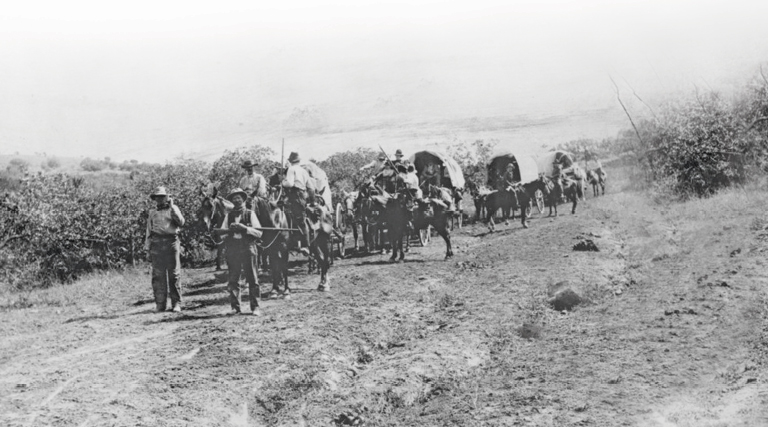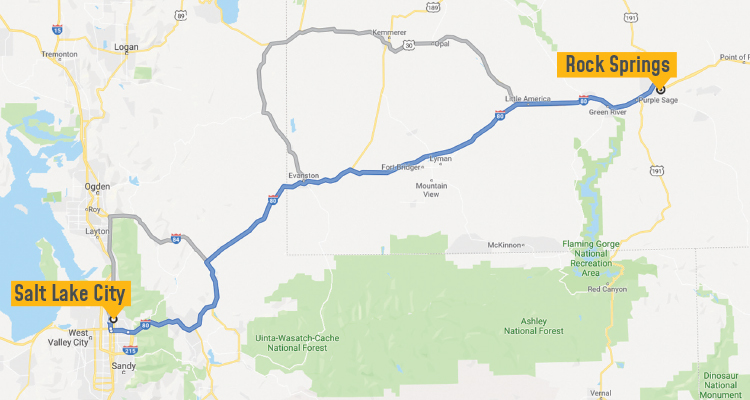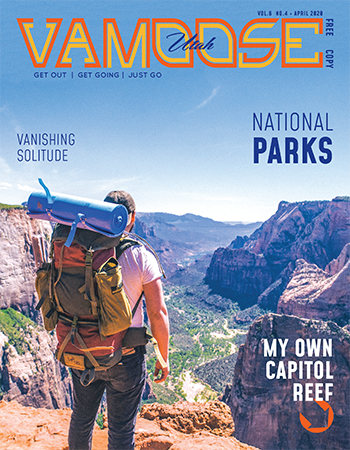Finding your groove along the Mormon Pioneer Trail
By Kathleen Curry and Geoff Griffin
Salt Lake City is dotted with statues, buildings and historical markers that revere the Latter-day Saint pioneers who arrived in Utah in 1847 (see “Street Smarts,” p. 14). There are journals and history books telling their stories. Every July 24, pioneers are celebrated with a parade and festivities. It’s one thing to read about them, but quite another to actually experience trekking through the wilderness like they did.
Within a three-hour drive of Salt Lake City, it’s possible to put yourself in their footsteps along the last leg of the Mormon Trail. From 1846 to 1869, more than 70,000 members of the LDS faith traveled along the Mormon Trail. In some spots in southwest Wyoming, you still can see exposed wagon ruts more than 150 years later. There are overlooks along the way where you can imagine covered wagons skidding down the side of a mountain. It’s still possible to experience what it was like, standing alongside trails where the pioneers would have trudged by in 1847, feeling their desolation knowing there were still weeks of travel before they’d reach Salt Lake Valley.
Today, LDS church members dress up in period garb and pull handcarts for multiple days to get a sense of what the journey was like. But you can experience the Mormon Trail as a weekend getaway by driving across the border into Wyoming and following this itinerary:
Thursday Afternoon
SLC to Rock Springs, Wyo.
Head east on Interstate 80 for 2 ½ hours until you arrive in Rock Springs, Wyo. The town sits in the heart of Sweetwater County, boasting more exposed pioneer trails of any place in America. You’ll see wagon-wheel marks along several trails, including the Mormon Trail.
As for accommodations, there are more than 2,000 hotel rooms in the Rock Springs area, including many national chains. One option is the Best Western Outlaw Inn (1630 Elk St., Rock Springs, Wyo., 307-362-6623, OutlawInnWyom.com) which first opened in 1966 just before I-80 came through. It’s still family-owned today.
Once you get settled, head out to dinner at Coyote Creek Steakhouse and Saloon (404 N. St., Rock Springs, Wyo., 307-382-4100, CoyoteCreekRS.com) For the steakhouse portion of the evening, the prime rib is a can’t-miss. Don’t be afraid to try the shrimp cocktail with housemade sauce. For the saloon, check out Coyote’s bloody mary with housemade mix and pickled asparagus.
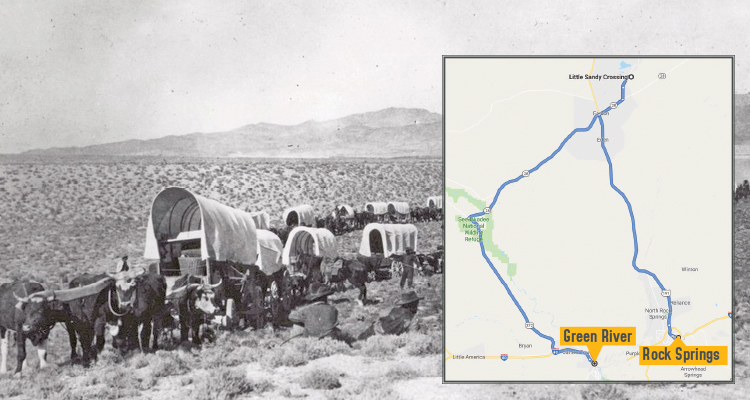
Historic photo of wagon trains traversing the West
Friday Morning
Rock Springs to Green River, Wyo.
While the Outlaw Inn offers a free hot breakfast, you might also consider the hotel’s Open Range on-site restaurant where fresh Idaho trout is on the breakfast menu with eggs and hash browns on the side. While there, grab one of their box lunches to go, since you’ll be out exploring pioneer trails for the day.
Take US 191 north out of Rock Springs for 42 miles to arrive at the junction with Wyoming Highway 28. For the rest of the day, head southwest on WYO-28 and look for Mormon Trail markers and interpretive signs beside the roadway. You can pull over as often as your level of interest and time constraints allow. Some may require you to walk 50 to 100 yards to see exposed wagon ruts or other points of interest. Visit HistoricTrailMedals.com/trailmormon for tour highlights, plus NPS.gov/mopi for detailed maps.
In the mid-1800s, Sweetwater County was an intersection of sorts for a variety of westward routes, so visitors can also find remnants from the Oregon, California, Overland, Donner and Cherokee trails.
The first notable spot along Highway 28 is Little Sandy Crossing near the junction with US 191, which in 2019, is about a four-hour drive from Salt Lake City. In 1847, the LDS pioneers arrived there on June 28, meaning they were still nearly a month from hearing Brigham Young utter, “This is the place,” on July 24.
Little Sandy Crossing is also where Young met Jim Bridger. The story goes that when he asked the mountain man if he knew anything about the Salt Lake Valley, Bridger laughed, saying he’d give $1,000 for the first bushel of corn grown there.
After the pioneers crossed the Sandy River, it would take them two days to reach the Green River, where they would face a much bigger challenge. Nowadays, the drive from the Sandy to the Green on Highway 28 takes about 30 minutes. An interpretive station at Green River explains how the pioneers ferried their wagons and livestock across the water.
Once you’ve reached the Green River, you’re not far from the Wyoming town of the same name. When WYO 28 dead-ends into Highway 372, turn left and head south. The road will run in and out of Seedskadee National Wildlife Refuge (FWS.gov/refuge/seedskadee) before taking you into the town. You will have already passed by Green River on your way to Rock Springs since it’s 15 miles west of Rock Springs along I-80. This time, stop and enjoy dinner at the Hitching Post Restaurant and Saloon (580 E. Flaming Gorge Way, Green River, 307-875-2246, HitchingPostGR.com). Noted for its large salad bar, its menu runs the gamut from beef stroganoff to chili cheese fries to a Reuben sandwich. The restaurant closes at 10 p.m., but the saloon stays open until 2 a.m.
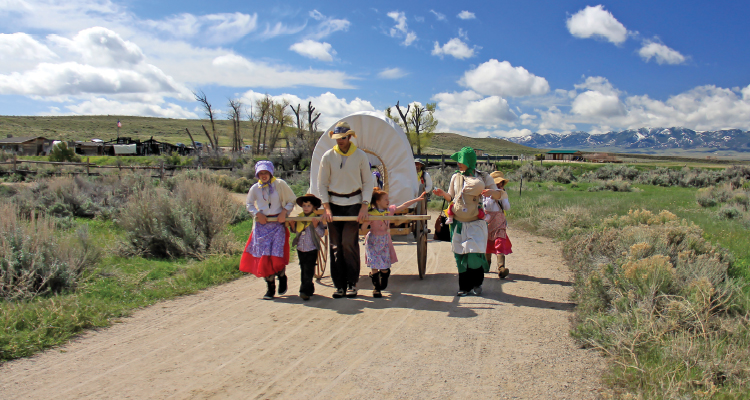
Today, the LDS Church offers handcart trek re-enactments to wards, stakes, families and other approved groups
Saturday Morning
Green River to Fort Bridger & Mountain View
Start the day at Cowboy Donuts (1573 Dewar St., Green River, Wyo., 307-362-3400, CowboyDonuts.com) where their catchphrase is “Dang good donuts.” With hot kolaches, specialty donuts and a full range of coffee, you’ll find a way to get your day going in the right direction.
Your next destination is Fort Bridger, and you can choose from two ways to get there. You either can hop on I-80 West and reach your destination in about an hour or take two hours and swing down through Flaming Gorge to enjoy beautiful views while crossing the state line into the Utah town of Manila. Then, you’ll return to I-80 via Wyoming Highway 414. Just before reaching I-80, you’ll want to stop at Fort Bridger State Historic Site (37001 Interstate 80 Business Loop, Fort Bridger, Wyo., 307-782-3842, WyoParks.State.Wy.us)
Jim Bridger and Louis Vasquez opened the fort with a store and blacksmith shop in 1843 after Bridger noticed that many passing wagon trains, “are generally well supplied with money, but by the time they get here they are in need of all kinds of supplies, provisions, smith-work, etc.”
The Mormon pioneers were among those groups when they passed by in 1847. Their history continued at Fort Bridger when they came back and took it over in 1853. The Mormons claimed they bought it from Vasquez while Bridger was out of town, but Bridger claimed the Mormons drove him out because Brigham Young didn’t like him selling liquor to Native Americans.
Either way, the Latter-day Saints ended up using the fort from 1853-57 as a place for incoming pioneers to stop and rest for the final part of their journey. In 1857, the U.S. Army was on its way to Utah to let Young know who was in charge. The Mormons burned the fort to the ground rather than allowing the Army to take shelter or grab provisions for their long march.
In all, Fort Bridger saw five different eras of occupation. Today, all five can be experienced on a 37-acre property containing 27 historic buildings and four replica structures.
After your visit, the town of Mountain View is adjacent to Fort Bridger. You can spend the night there at Country Cabins Inn (21 Seventh St., Mountain View, Wyo., 307-782-7888, CountryCabinsInn.com) where you can enjoy your own private cabin that includes a shower and jetted-tub along with a kitchenette. On-site, you’ll find Zheng Zhong Chinese Restaurant, which serves Chinese and Thai dishes. Their online reviews from patrons generally go something like, “I was stunned to find a really good Chinese/Thai restaurant in the middle of Wyoming.”
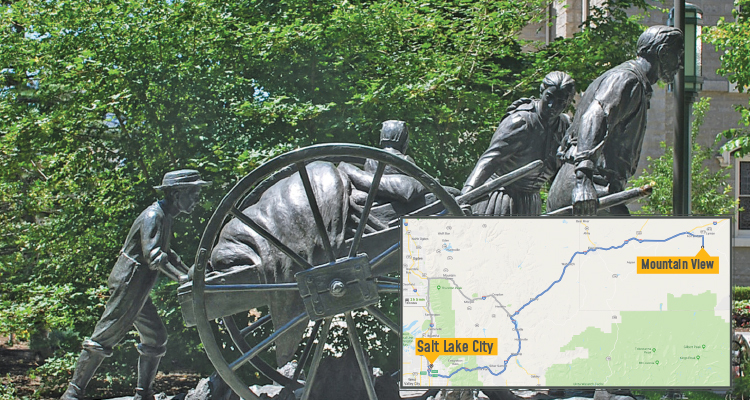
Handcart Pioneer Monument at Temple Square
Sunday Morning
Mountain View, Wyo., to SLC
Before leaving Mountain View, head over to the Crazy Ate Café and Steakhouse (971 N. Highway 414, Mountain View, Wyo., 307-782-7455, CrazyAteCafe.com) where their claim to fame is a giant homemade cinnamon roll weighing in at 3 pounds. We’re not saying that you have to order it, but you may not ever get another chance at a roll that huge.
After breakfast, get back on I-80 and head west. You’ll hit the Wyoming/Utah state line in about 45 minutes. Once in Utah, take Exit 178 for Echo Canyon Road (you can only make this exit when heading west). Echo Canyon Road was once the Lincoln Highway and generally runs parallel to I-80.
While heading southwest on Echo Canyon Road, you’ll have access to several pioneer-related sites. About nine miles along Echo Canyon Road, you can see Steamboat Rocks—also known as Noah’s Ark. Brigham Young and company camped there in 1847, and it became a major landmark for Mormon emigrants who came through in later years, letting them know they weren’t too far from the finish line.
About 12 miles from the exit, you’ll come to the tiny town of Echo. Just off the road, you’ll spot an area with a number of interpretive exhibits, plus you’ll find several historical buildings.
The town of Echo is where Echo Canyon Road turns into Echo Road and alters its orientation from southwest to northwest, heading toward the town of Henefer. Echo Road runs parallel to Interstate 84. Once in Henefer, you’ll cross I-84 to enter Utah State Route 65.
Once on SR-65, continue about 5 miles to the Big Mountain Rest Area—the place where the pioneers caught their first glimpse of Salt Lake Valley. At this stage, they needed to get down the mountain but didn’t have switchbacks like we do today. Their solution was to lock the wheels on their wagons with chains and slowly skid the wagons down the mountainside. As you get back in your car and head down the mountain, you’ll be able to see other spots of the old trail scar as the modern road switches back and forth.
Continuing down SR-65, you’ll come to Little Dell Reservoir. At this point, you could stay on the road a few more miles and hook back up with I-80, but we recommend turning right onto Emigration Canyon Road, which brings you down the same canyon the Mormon pioneers traveled in 1847. This is also where you’ll find your final stop before heading home, Ruth’s Diner (4160 Emigration Canyon Road, Salt Lake City, 801-582-5807, RuthsDiner.com). OK, a place with a make-your-own bloody mary bar that’s open on Sundays doesn’t necessarily have much to do with Mormon pioneer history. However, Ruth Evans, the founder, was born in the 19th century, as were many of the pioneers, and is there anything that’s more of a Salt Lake classic than sitting on the patio at Ruth’s on a sunny day and eating mile-high biscuits? Slap on plenty of butter and jam and give thanks that you live in 2019 while appreciating the skill, courage and ingenuity of those who came before.

